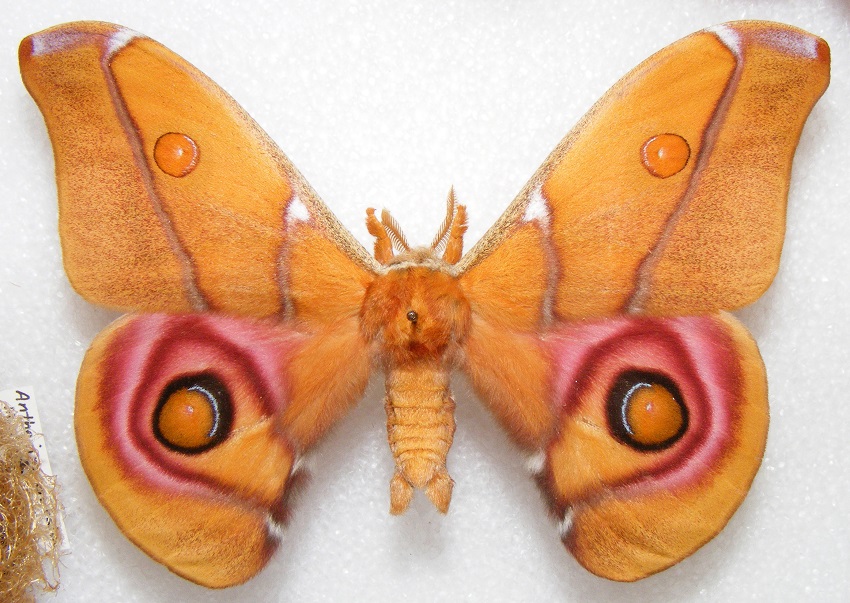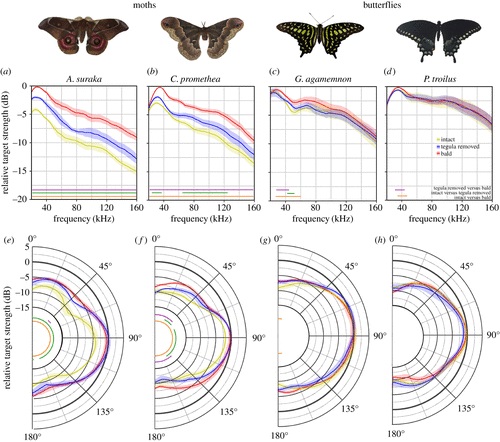When I was a kid, I thought moths were by far the dumbest insect on the planet. They always pretend that you can’t see them, they flutter in your face at the most inopportune times, and I have seen many moths fly right into an open flame. Dumb!
But, the more I learned about biology, the more respect I have gained for moths. Not only do moths have a very interesting life cycle, but moths have also developed a number of defense mechanisms to avoid their main predator – Bats!
While it has long been established that some moths have evolved sensory organs to hear the ultrasonic squeal of an approaching bat, scientists were confused about how moths without these organs avoided bats. By all accounts, moths without an ultrasonic hearing organ should be extinct!

Finally, researchers have uncovered an important defense mechanism these moths use to avoid bats. In a recently published article, researchers have identified a second strategy that moths use to avoid bats, even if they don’t have ultrasonic ears.
These moths use a super high-tech type of scale that absorbs ultrasonic frequencies like the sound insulation in a recording studio, essentially making these moths invisible to a bat’s ultrasonic sonar!
To see why this is such a cool biology story, we have to look at a couple of different biological concepts: Defensive Adaptations and Predator-Prey Coevolution.
Defensive Adaptations
The scales these moths produce are a perfect lesson in defensive adaptations. While other types of moths have been evolving ultrasonic-hearing organs, these moths never inherited the mutations and genetic changes necessary to develop these defenses.
But, that doesn’t mean these moths were doing nothing.
Evolution is a process that occurs as the variation in a population is systematically tested. In moths, the test is simple: did the moth get to reproduce before it was eaten by a bat? Variations that do not help moths survive and reproduce are lost, while any variations present in the next generation can be considered “beneficial”.
Many species of moth have gained variations that make them sensitive to the ultrasonic frequencies bats emit. This strategy has been well-documented, and researchers have even shown that when these moths sense an ultrasonic frequency, they stop flapping and begin a wild and random freefall to the ground. This helps them avoid the bat, and hopefully survive to reproduce.
But, this new study shows that moths have evolved another defensive adaptation: “stealth-mode”. Instead of listening for the ultrasonic frequencies, these moths simply ensure that the signal never makes it back to the bat. The scales that they have evolved over time ensure that the signal is absorbed, rather than reflected. To the bat, this makes them effectively invisible!

As you can see in the graphic above, researchers found that at ultra-high frequencies bats use for sonar, the scales on these moths block nearly 25% of the returning signal. The two species on the left show a much lower target strength at a number of ultrasonic frequencies. Butterflies (on the right) do not have these scales, and they are much easier for bats to detect because the returning ultrasonic signal is so much stronger.
This can confuse a bat chasing a moth, making it think that the signal is only a small insect or some small particle. This lowers the chance that the bat will recognize the moth as food. Thus, the survival rate of these moths increases. Evolution!
Coevolution between Predator and Prey
That brings us to our second important biological concept displayed by this system: Predator-prey coevolution.
Coevolution is a process through which two or more species actively affect one another’s evolutionary trajectory. In simple terms, bats and moths are evolving together based on the adaptations each group evolves!
Long before the first bats, insects likely had total dominance of the skies. Ultrasonic hearing or stealthy scales were not necessary, because there were no predators chasing them in the skies. Then, birds and bats evolved. These creatures could pursue insects in the skies. That’s when the “arms race” began.
Bats, apparently in an effort to not compete with birds, evolved to become nocturnal. But, this brought up several issues. First and foremost, bats could no longer see where they were flying or what they were chasing. So, they started listening.
Over the course of millions of years, bats evolved the ability to navigate using ultrasonic sonar. The bats send out a “click” and listen for the sound waves to bounce off of solid objects. In this case, insects.
At first, the moths likely lost the battle. Without any defenses against this ultrasonic adaptation, the moths were eaten up. But, a few novel variants made it through the carnage. Moths evolved things like ultrasonic hearing and the newly discovered “stealth-scales”, that gave them a leg up in the war.
These back-and-forth adaptations are a perfect example of predator-prey coevolution, which happens between predator and prey species in all ecosystems around the globe. But, it doesn’t stop here. Moths and bats will both continue evolving traits to fight the war.
Who knows? Someday we may have bats that can kill moths with their ultrasonic clicks and moths with massive defensive scales to absorb the blows!
